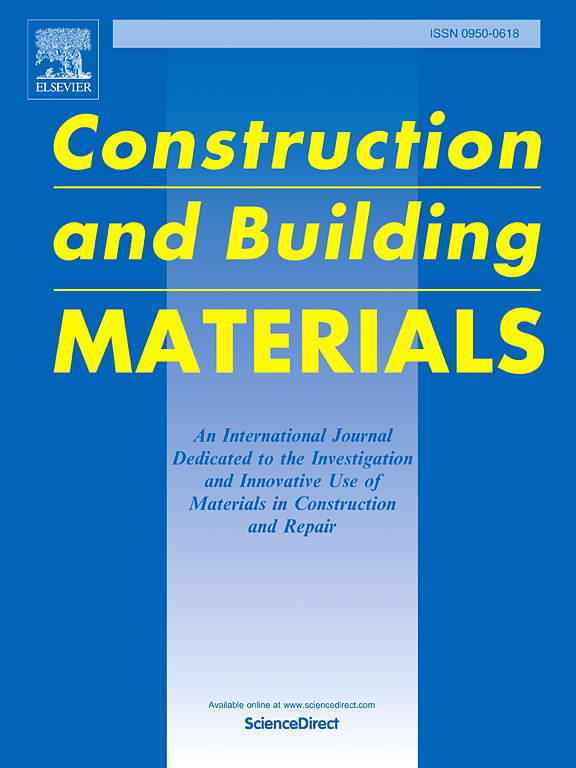热混合沥青添加剂磷石膏的制备及性能
IF 7.4
1区 工程技术
Q1 CONSTRUCTION & BUILDING TECHNOLOGY
引用次数: 0
摘要
磷石膏是一种典型的工业固体废物,在世界范围内对环境和经济构成了重大挑战。本研究旨在利用磷石膏中的结晶水,开发一种新型的温拌沥青添加剂,从而实现高价值利用,并解决其作为温拌添加剂的性能变异性。首先,采用大气酸化法合成了一种纯度高、杂质少的磷石膏热混添加剂(PWMA)。随后,通过x射线衍射(XRD)、x射线荧光光谱(XRF)、扫描电镜(SEM)、傅里叶变换红外光谱(FTIR)和热重分析(TG)对PWMA进行了表征。最后,对实验室制备的含PWMA和传统热混合沥青(HMA)混合料的WMA混合料进行了综合工程性能试验,包括湿敏感性试验、车轮跟踪试验、梁弯曲试验和四点弯曲试验。实验结果表明,大气酸化法有效地降低了磷石膏中的杂质含量,得到的二水硫酸钙纯度超过99 %的PWMA。红外吸收峰在3390 cm⁻¹和1620 cm⁻¹处与羟基(O-H)振动相对应,表明PWMA中存在结晶水分子,证实了PWMA的释水能力。在50-100 ℃之间,PWMA表现出初始失重阶段,失重率为0.29 %,这主要是由于大气中含有游离水分子的水分被吸附所致。第二次失重阶段开始于100 ℃,在150 ℃时,由于结晶水的释放,质量损失20.7 %。与HMA相比,添加pwma的WMA混合物的整体性能优越,低温和水稳定性略有降低,但仍具有可比性和令人满意的性能。本研究证实了磷石膏作为一种有效和可持续的WMA添加剂的可行性。本文章由计算机程序翻译,如有差异,请以英文原文为准。
Phosphogypsum as a warm mix asphalt additive: Preparation and performance
Phosphogypsum is a typical industrial solid waste that presents significant environmental and economic challenges worldwide. This study aims to exploit the crystalline water in phosphogypsum to develop a novel warm-mix asphalt additive, thereby achieving high-value utilization and addressing the variability in the performance as a warm-mix additive. Initially, the atmospheric acidification method was employed to synthesize a phosphogypsum warm-mix additive (PWMA) with high purity and minimal impurities. Subsequently, the PWMA was characterized through X-ray diffraction (XRD), X-ray fluorescence spectroscopy (XRF), scanning electron microscopy (SEM), Fourier-transform infrared spectroscopy (FTIR), and thermogravimetric analysis (TG). Finally, the laboratory-prepared WMA mixture containing PWMA and traditional hot-mix asphalt (HMA) mixture underwent comprehensive engineering performance tests, including moisture susceptibility test, wheel-tracking test, beam bending test, and four-point bending test. The experimental results demonstrated that the atmospheric acidification method effectively reduced the impurity content in phosphogypsum, yielding a PWMA with calcium sulfate dihydrate purity exceeding 99 %. The infrared absorption peaks at 3390 cm⁻¹ and 1620 cm⁻¹ correspond to hydroxyl (O-H) vibrations, indicating the presence of crystalline water molecules in PWMA and confirming its water-releasing capability. The PWMA exhibited its initial weight loss stage between 50–100 ℃, with a 0.29 % mass loss, attributed to the adsorption of atmospheric moisture containing free water molecules. The second weight loss stage commenced at 100 ℃, with a 20.7 % mass loss at 150 ℃, attributed to crystalline water release. PWMA-added WMA mixtures demonstrated overall superior performance compared to HMA, with slightly reduced low-temperature and water stability, yet remaining comparable and satisfactory. This study confirms the viability of phosphogypsum as an effective and sustainable WMA additive.
求助全文
通过发布文献求助,成功后即可免费获取论文全文。
去求助
来源期刊

Construction and Building Materials
工程技术-材料科学:综合
CiteScore
13.80
自引率
21.60%
发文量
3632
审稿时长
82 days
期刊介绍:
Construction and Building Materials offers an international platform for sharing innovative and original research and development in the realm of construction and building materials, along with their practical applications in new projects and repair practices. The journal publishes a diverse array of pioneering research and application papers, detailing laboratory investigations and, to a limited extent, numerical analyses or reports on full-scale projects. Multi-part papers are discouraged.
Additionally, Construction and Building Materials features comprehensive case studies and insightful review articles that contribute to new insights in the field. Our focus is on papers related to construction materials, excluding those on structural engineering, geotechnics, and unbound highway layers. Covered materials and technologies encompass cement, concrete reinforcement, bricks and mortars, additives, corrosion technology, ceramics, timber, steel, polymers, glass fibers, recycled materials, bamboo, rammed earth, non-conventional building materials, bituminous materials, and applications in railway materials.
 求助内容:
求助内容: 应助结果提醒方式:
应助结果提醒方式:


